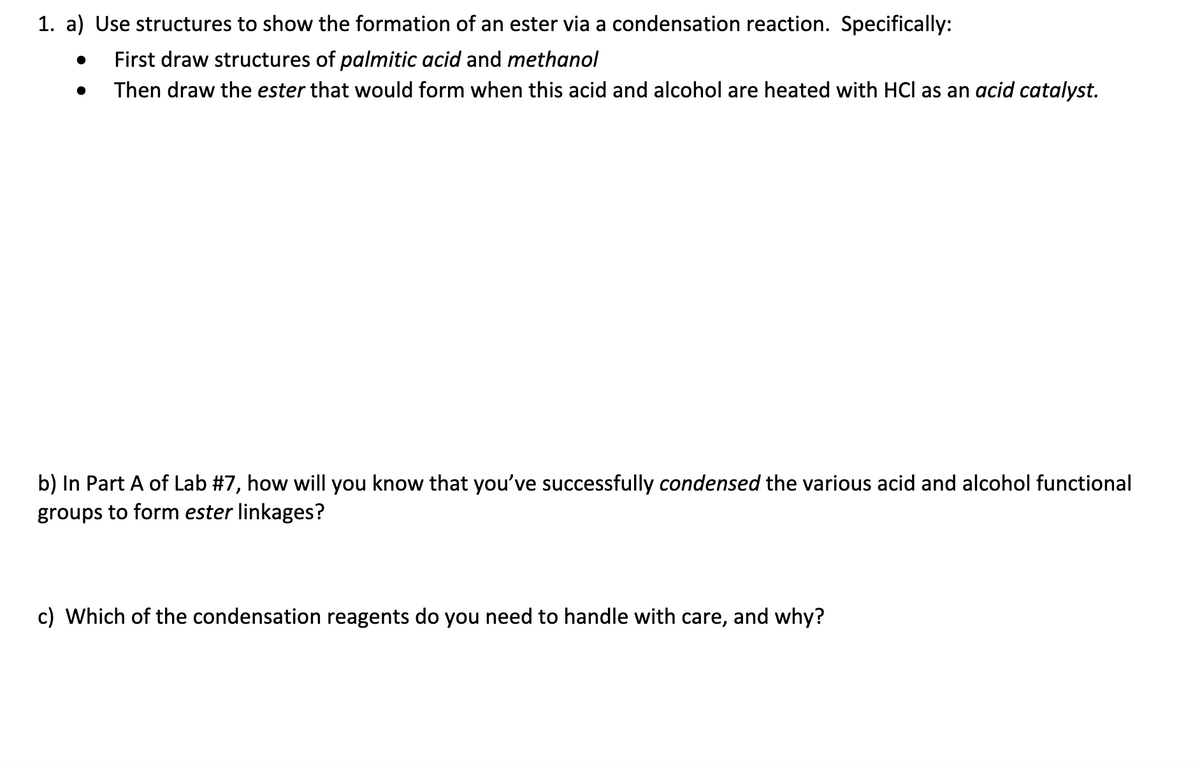1. a) Use structures to show the formation of an ester via a condensation reaction. Specifically: First draw structures of palmitic acid and methanol Then draw the ester that would form when this acid and alcohol are heated with HCl as an acid catalyst. ● ● b) In Part A of Lab #7, how will you know that you've successfully condensed the various acid and alcohol functional groups to form ester linkages? c) Which of the condensation reagents do you need to handle with care, and why?
1. a) Use structures to show the formation of an ester via a condensation reaction. Specifically: First draw structures of palmitic acid and methanol Then draw the ester that would form when this acid and alcohol are heated with HCl as an acid catalyst. ● ● b) In Part A of Lab #7, how will you know that you've successfully condensed the various acid and alcohol functional groups to form ester linkages? c) Which of the condensation reagents do you need to handle with care, and why?
Principles of Modern Chemistry
8th Edition
ISBN:9781305079113
Author:David W. Oxtoby, H. Pat Gillis, Laurie J. Butler
Publisher:David W. Oxtoby, H. Pat Gillis, Laurie J. Butler
Chapter7: Bonding In Organic Molecules
Section: Chapter Questions
Problem 42AP
Related questions
Question

Transcribed Image Text:1. a) Use structures to show the formation of an ester via a condensation reaction. Specifically:
First draw structures of palmitic acid and methanol
Then draw the ester that would form when this acid and alcohol are heated with HCl as an acid catalyst.
●
b) In Part A of Lab #7, how will you know that you've successfully condensed the various acid and alcohol functional
groups to form ester linkages?
c) Which of the condensation reagents do you need to handle with care, and why?
Expert Solution
This question has been solved!
Explore an expertly crafted, step-by-step solution for a thorough understanding of key concepts.
This is a popular solution!
Trending now
This is a popular solution!
Step by step
Solved in 4 steps with 1 images

Knowledge Booster
Learn more about
Need a deep-dive on the concept behind this application? Look no further. Learn more about this topic, chemistry and related others by exploring similar questions and additional content below.Recommended textbooks for you

Principles of Modern Chemistry
Chemistry
ISBN:
9781305079113
Author:
David W. Oxtoby, H. Pat Gillis, Laurie J. Butler
Publisher:
Cengage Learning

Chemistry & Chemical Reactivity
Chemistry
ISBN:
9781337399074
Author:
John C. Kotz, Paul M. Treichel, John Townsend, David Treichel
Publisher:
Cengage Learning

Chemistry & Chemical Reactivity
Chemistry
ISBN:
9781133949640
Author:
John C. Kotz, Paul M. Treichel, John Townsend, David Treichel
Publisher:
Cengage Learning

Principles of Modern Chemistry
Chemistry
ISBN:
9781305079113
Author:
David W. Oxtoby, H. Pat Gillis, Laurie J. Butler
Publisher:
Cengage Learning

Chemistry & Chemical Reactivity
Chemistry
ISBN:
9781337399074
Author:
John C. Kotz, Paul M. Treichel, John Townsend, David Treichel
Publisher:
Cengage Learning

Chemistry & Chemical Reactivity
Chemistry
ISBN:
9781133949640
Author:
John C. Kotz, Paul M. Treichel, John Townsend, David Treichel
Publisher:
Cengage Learning

Chemistry: The Molecular Science
Chemistry
ISBN:
9781285199047
Author:
John W. Moore, Conrad L. Stanitski
Publisher:
Cengage Learning

Chemistry: Principles and Reactions
Chemistry
ISBN:
9781305079373
Author:
William L. Masterton, Cecile N. Hurley
Publisher:
Cengage Learning

Introductory Chemistry: An Active Learning Approa…
Chemistry
ISBN:
9781305079250
Author:
Mark S. Cracolice, Ed Peters
Publisher:
Cengage Learning